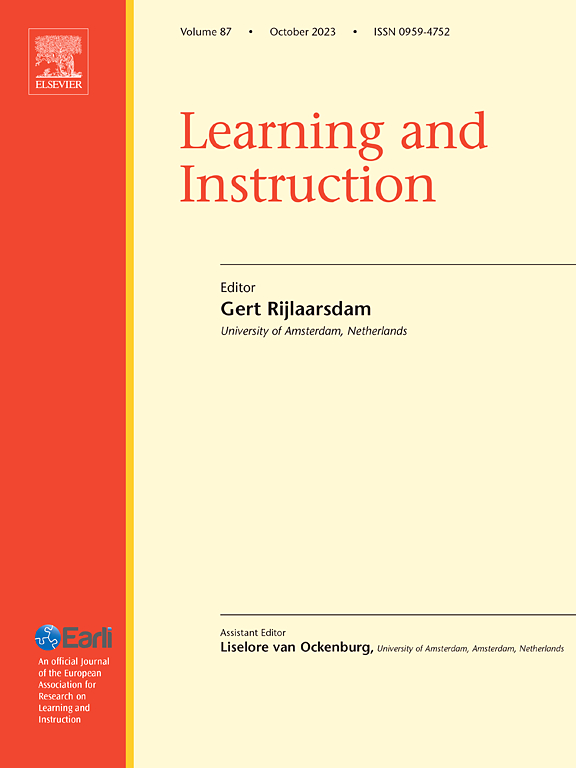The impact of goal self-concordance on emotion regulation during academic goal pursuit: A multilevel latent profile analysis approach
IF 4.9
1区 教育学
Q1 EDUCATION & EDUCATIONAL RESEARCH
引用次数: 0
Abstract
Background
Goal pursuit is a key aspect of students’ life. Research shows self-concordant goals predict the type of emotion regulation strategies during academic goal striving, influencing goal outcomes. However, recent studies using multilevel latent profile analysis (ML-LPA) suggest considering the degree and consistency of emotion regulation strategy use alongside type.
Aims
This study examined how self-concordant goals affect the type, degree, and consistency of emotion regulation efforts in pursuing academic goals. Using ML-LPA, we identified profiles encompassing these dimensions and explored the role of emotion regulation profile membership as mediator of goal self-concordance and goal pursuit outcomes.
Theoretical framework
The study was based on the self-concordance model (Sheldon, 2014) and Bonanno and Burton's (2013) framework for emotion regulation flexibility.
Sample
The sample consisted of 366 undergraduates (77 % female, M age = 20.04, SD = 1.49).
Methods
In a daily diary study, participants reported on an academic goal and its self-concordance each morning. In the evening, they reported on emotion regulation strategies for negative goal-related emotions and goal pursuit outcomes.
Results
Four day-level and five person-level profiles were identified. Goal self-concordance predicted optimal outcomes through increased membership likelihood in adaptive emotion regulation profiles—characterized by engagement-type strategies and an average degree of emotion regulation implementation—and through reduced membership likelihood in maladaptive profiles, typified by low degree of emotion regulation implementation and inconsistent strategy use.
Conclusions
This study expands our knowledge of the processes underlying academic goal pursuit, by clarifying the emotion regulation processes mediating the relationship between goal motivation and outcomes.
学业目标追求过程中目标自我和谐对情绪调节的影响:一种多层次潜在剖面分析方法
目标追求是学生生活的一个重要方面。研究表明,自我和谐目标预测学业目标追求过程中的情绪调节策略类型,影响学业目标的实现。然而,最近的研究使用多层次潜在轮廓分析(ML-LPA)建议考虑情绪调节策略使用的程度和一致性以及类型。目的研究自我和谐目标对学业目标追求中情绪调节的类型、程度和一致性的影响。利用ML-LPA,我们确定了包含这些维度的特征,并探讨了情绪调节特征隶属度在目标自我和谐和目标追求结果中的中介作用。理论框架本研究基于自我和谐模型(Sheldon, 2014)和Bonanno和Burton(2013)的情绪调节灵活性框架。样本366名大学生,其中女性77%,年龄M = 20.04, SD = 1.49。方法在一项每日日记研究中,参与者每天早上报告一个学术目标及其自我一致性。晚上,他们报告了消极目标相关情绪和目标追求结果的情绪调节策略。结果确定了4个日水平和5个人水平的档案。目标自我和谐通过提高适应性情绪调节档案(以敬业型策略和平均情绪调节实施程度为特征)的成员可能性,以及降低适应不良档案(以低情绪调节实施程度和不一致的策略使用为特征)的成员可能性来预测最佳结果。结论本研究通过阐明情绪调节过程在目标动机与结果之间的中介作用,拓展了我们对学业目标追求过程的认识。
本文章由计算机程序翻译,如有差异,请以英文原文为准。
求助全文
约1分钟内获得全文
求助全文
来源期刊

Learning and Instruction
Multiple-
CiteScore
11.30
自引率
4.80%
发文量
109
期刊介绍:
As an international, multi-disciplinary, peer-refereed journal, Learning and Instruction provides a platform for the publication of the most advanced scientific research in the areas of learning, development, instruction and teaching. The journal welcomes original empirical investigations. The papers may represent a variety of theoretical perspectives and different methodological approaches. They may refer to any age level, from infants to adults and to a diversity of learning and instructional settings, from laboratory experiments to field studies. The major criteria in the review and the selection process concern the significance of the contribution to the area of learning and instruction, and the rigor of the study.
 求助内容:
求助内容: 应助结果提醒方式:
应助结果提醒方式:


